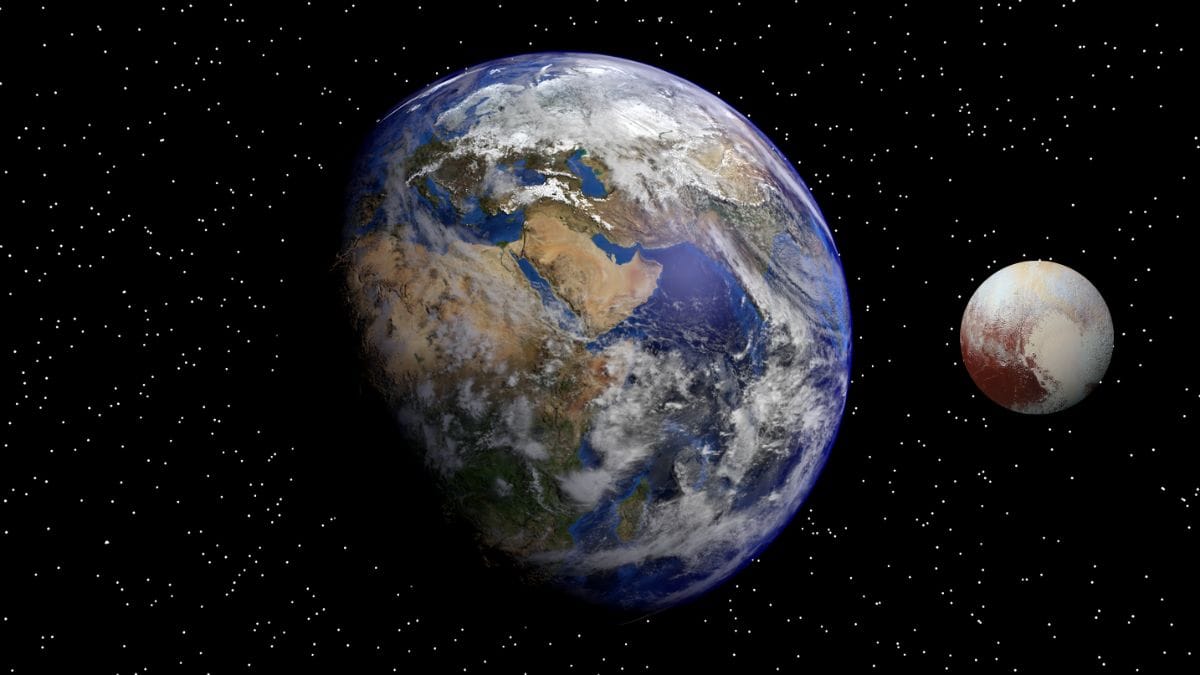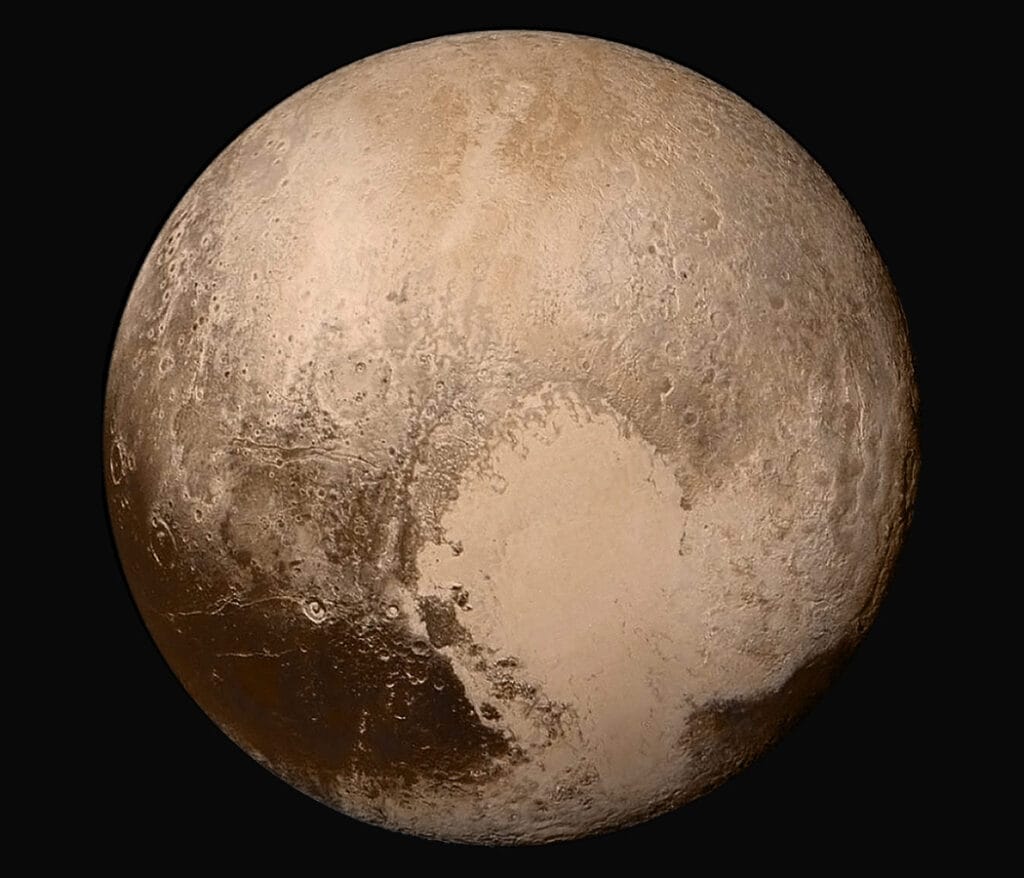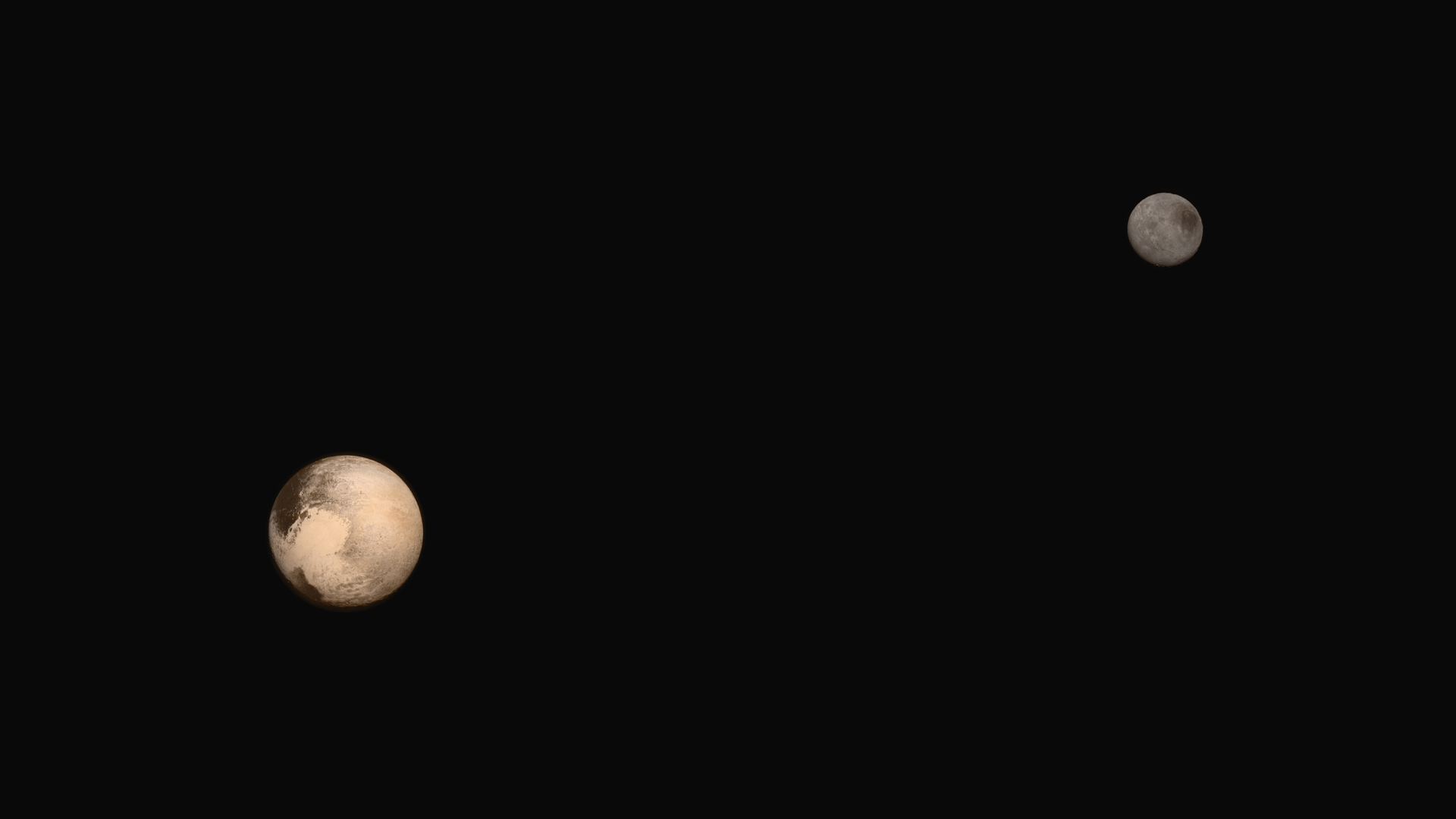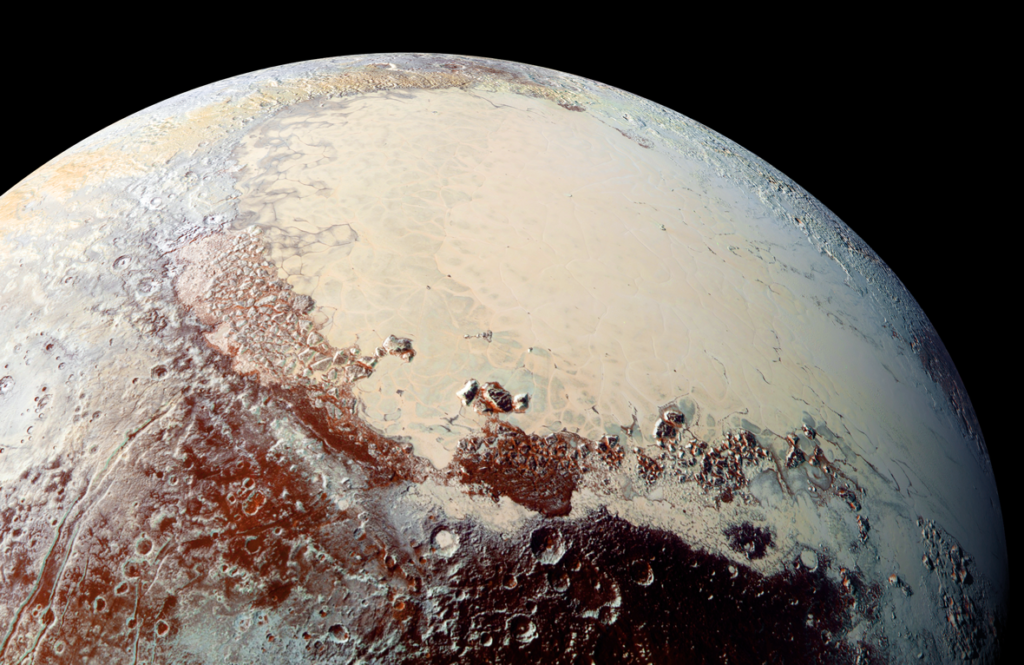
Imagine a world where the familiar glow of our Moon is replaced by a distant, icy orb once called the ninth planet, now revealing secrets through NASA’s latest missions. Pluto, explored in detail by the New Horizons spacecraft during its historic flyby on July 14, 2015, stands as a dwarf planet with a diameter of 2,377 kilometers and a mass just 0.0022 times that of Earth, according to NASA’s comprehensive Pluto facts. Recent analyses in 2025, marking the 10th anniversary of New Horizons, highlight Pluto’s dynamic surface with nitrogen glaciers and possible subsurface oceans, drawing parallels to how such a body might interact if orbiting Earth instead of the Sun.
This scenario invites us to explore gravitational dances and geological wonders, much like official briefings on lunar missions. Earth’s current Moon, with its 3,474-kilometer diameter and mass of 7.346 x 10^22 kilograms, stabilizes our planet’s tilt and drives ocean tides, as detailed in NASA’s Moon facts overview. Swapping it for Pluto, an icy world coated in methane and nitrogen frosts, could reshape everything from nightly skies to daily rhythms. Building on peer-reviewed models of tidal interactions, such as those in a 2024 study examining body tides on heterogeneous worlds, we can hypothesize profound changes.
But how would this cosmic switch alter tides, skies, and even life on Earth?
What Are the Main Differences Between Pluto and Earth’s Moon?
Searchers often ask about the contrasts between Pluto and our Moon to grasp their unique traits. Pluto measures 2,377 kilometers in diameter, roughly two-thirds that of the Moon’s 3,474 kilometers, making it smaller yet denser in some aspects with a mean density of 1,854 kilograms per cubic meter compared to the Moon’s 3,344 kilograms per cubic meter, as per NASA’s Pluto fact sheet. This difference stems from composition: Pluto likely features a rocky core surrounded by water ice mantles and surface ices like methane and nitrogen, while the Moon has an iron-rich core, silicate mantle, and crust rich in oxygen and silicon.

Mass tells another story, with Pluto at 1.303 x 10^22 kilograms, about one-sixth the Moon’s 7.346 x 10^22 kilograms, influencing gravitational pull—Pluto’s surface gravity is 0.62 meters per second squared (m/s²), weaker than the Moon’s 1.62 m/s². Fun comparison: standing on Pluto would feel like weighing just 6 percent of your Earth weight, even lighter than the Moon’s 16 percent. Surface features vary too; Pluto boasts mountains up to 3 kilometers high made of water ice and vast plains like Sputnik Planitia, a nitrogen glacier spanning 1,000 kilometers, revealed by New Horizons in 2015 and analyzed in NASA’s 2020 summary of 10 key Pluto discoveries, updated with 2025 insights on ongoing geological activity.
The Moon, in contrast, displays impact craters like Tycho at 85 kilometers wide and dark maria (basalt plains) from ancient lava flows. Pluto has a thin atmosphere of nitrogen with methane and carbon monoxide, extending high due to low gravity, unlike the Moon’s negligible exosphere. If values differ slightly, such as diameter estimates ranging 2,376 to 2,377 kilometers from radio occultation data, it’s due to measurement precision in NASA’s Pluto profile. To visualize these layers, consider diagrams from NASA’s fact sheets showing cross-sections—Pluto’s icy shell versus the Moon’s rocky depth.
Bullet points for quick comparison:
- Size: Pluto 2,377 km vs. Moon 3,474 km (Pluto smaller by 31 percent).
- Mass: Pluto 1/6 Moon’s (weaker gravity effects).
- Composition: Pluto icy volatiles; Moon silicates and metals.
- Atmosphere: Pluto tenuous but present; Moon virtually none.
- Surface: Pluto dynamic glaciers; Moon static craters.
These disparities set the stage for dramatic hypothetical shifts if Pluto orbited Earth.
How Would Tides on Earth Change If Pluto Replaced the Moon?
A popular query explores tidal transformations in this swap. Tides arise from gravitational pull creating ocean bulges, with the Moon’s mass pulling water toward it and inertia forming an opposite bulge, as explained in NASA’s tides resource. With Pluto’s mass one-sixth the Moon’s, tidal forces—proportional to mass over distance cubed (if at the same 384,400-kilometer average distance)—would weaken to about one-sixth current levels, leading to smaller high tides and less dramatic lows.
Current spring tides, amplified when Sun, Earth, and Moon align, reach up to 15 meters in places like the Bay of Fundy; with Pluto, they might max at 2.5 meters, altering coastal ecosystems. Neap tides, when pulls oppose, would be even milder. Fun fact: without strong tides, ancient life forms might not have transitioned to land as easily, since tides mix nutrients. Recent models from a 2024 peer-reviewed paper on tidal computations for heterogeneous bodies suggest Pluto’s lower density (1,854 kg/m³) and composition could add subtle variations, perhaps uneven heating if not perfectly spherical.
Uncertainties in mass ratios (0.177 to 0.18 across sources) stem from orbital data refinements. Visualizing this, imagine NASA’s tidal diagrams scaled down—bulges halved, oceans calmer. Bullet points on changes:
- Amplitude: Reduced by factor of 6 (mass ratio).
- Frequency: Still twice daily from Earth’s rotation.
- Coastal impact: Less erosion, altered habitats.
- Global: Weaker mixing of ocean layers (stratification effects).
This calmer sea could reshape weather patterns over time.
What Would Pluto Look Like in Earth’s Sky If It Were Our Moon?
Many wonder about the visual spectacle of Pluto overhead. At 384,400 kilometers away, Pluto’s 2,377-kilometer diameter yields an angular size of about 0.35 degrees, smaller than the Moon’s 0.5 degrees, appearing two-thirds as large in the sky per calculations using NASA’s distance data. Its surface, with red-brown tholins (organic compounds) and bright nitrogen plains, would glow dimly under sunlight, reflecting an albedo (reflectivity) of 0.49 to 0.66, similar to the Moon’s 0.12, but with hazy atmosphere scattering blue light for a faint glow.
Phases would cycle like the Moon’s, but Pluto’s retrograde rotation (east to west) and 57-degree axial tilt might show varying features if not tidally locked initially. Fun example: full “Pluto” nights could illuminate landscapes with a reddish tint, unlike the Moon’s white. From NASA’s New Horizons discoveries, dunes and cryovolcanoes might be visible through telescopes, adding intrigue. If distances vary (perigee 363,300 km to apogee 405,500 km), size fluctuates slightly, as with the Moon.

Suggest viewing NASA’s enhanced color maps for imagination—Pluto’s heart-shaped Tombaugh Regio shining prominently.
How Might Earth’s Rotation and Axis Change with Pluto as the Moon?
Questions frequently arise on rotational impacts. The Moon slows Earth’s rotation via tidal friction, lengthening days by 2.3 milliseconds per century, per NASA’s analyses. Pluto’s lesser mass would exert weaker friction, potentially keeping Earth’s day closer to its ancient 6-hour length longer, altering climate evolution. Axial stability, maintained by the Moon’s gravitational torque preventing excessive wobble, might weaken; Earth’s 23.5-degree tilt could vary more, causing extreme seasons.
Models in NASA’s 2024 study on body tides indicate mass ratio affects damping—Pluto’s 1/6 mass means less stabilization, risking tilts up to 60 degrees over millennia. Fun fact: without strong lunar influence, auroras might shift unpredictably. Uncertainties in tilt ranges (20-30 degrees nominal variation) come from simulation inputs.
Bullet points:
- Day length: Slower lengthening (less friction).
- Tilt: More wobble (weaker torque).
- Seasons: Potentially chaotic.
Visualize with orbital diagrams from NASA.
Could Pluto’s Atmosphere and Surface Activity Affect Earth?
Curiosity peaks on atmospheric interactions. Pluto’s thin nitrogen atmosphere, with pressure 10^-5 to 10^-6 bars and extending high, might interact minimally at lunar distance, but solar wind could strip particles toward Earth, per New Horizons data. Surface cryovolcanism, ejecting ammonia-water slurries from features like Wright Mons (150 km wide, 4 km high), could send faint plumes visible as hazy rings.
Compared to the Moon’s barren dust, Pluto’s active glaciers flowing at millimeters per year might evolve visibly over decades. From NASA’s Pluto insights, convection cells in Sputnik Planitia suggest internal heat, possibly radiating faintly. If pressures vary (seasonal collapse), minor gas releases occur.
Suggest thermal maps for visualization.

Would Pluto Remain Stable as Earth’s Moon?
Stability queries are common. At 384,400 km, beyond Earth’s Roche limit (9,500 km for fluid bodies), Pluto would hold together, unlike closer icy moons. Its lower gravity (0.62 m/s²) means less tidal stress from Earth, but Earth’s pull could induce quakes or resurfacing.
Peer-reviewed simulations of binary systems, like Pluto-Charon, in 2025 research on Pluto-Charon formation, suggest stability if orbits circularize. Fun: Pluto might tidally lock faster due to ice flexibility.
How Could This Scenario Impact Life on Earth?
Life effects intrigue many. Weaker tides might slow nutrient cycling, delaying complex life; less stable axis could cause ice ages more frequently. Pluto’s faint light (1/900 Sun’s brightness at noon there) would dim nights slightly less than the Moon.
From astrobiology perspectives in NASA’s tidal studies, habitability hinges on stable climates—disrupted here.
Conclusion
Swapping Earth’s Moon for Pluto would dial down tides, shrink the night sky’s beacon, and unsettle rotational stability, all rooted in mass and composition differences from NASA data. This thought experiment, grounded in New Horizons revelations and tidal models, underscores how celestial partners shape worlds.
Sources
Canup, R. M. (2025, January 7). SwRI models Pluto-Charon formation scenario that mimics Earth-Moon system. EurekAlert!. https://www.eurekalert.org/news-releases/1069681
Matsuyama, I., Beuthe, M., Hay, H., Nimmo, F., & Keane, J. T. (2024). A spectral method to compute the tides of laterally heterogeneous bodies. The Planetary Science Journal, 5(4), 381f. https://doi.org/10.3847/PSJ/ad381f
NASA. (2020, July 14). Five years after New Horizons’ historic flyby, here are 10 cool things we learned about Pluto. NASA. https://www.nasa.gov/solar-system/five-years-after-new-horizons-historic-flyby-here-are-10-cool-things-we-learned-about-pluto/
NASA. (2024, November 7). NASA-funded study examines tidal effects on planet and moon interiors. NASA Science. https://science.nasa.gov/science-research/planetary-science/astrobiology/studying-how-tides-affect-the-interiors-of-planets-and-moons/
NASA. (2025a). Tides. NASA Science. https://science.nasa.gov/resource/tides/
NASA. (2025b). Pluto: Facts. NASA Science. https://science.nasa.gov/dwarf-planets/pluto/facts/
NASA. (2025c). Moon facts. NASA Science. https://science.nasa.gov/moon/facts/
NASA Goddard. (2024a). Pluto fact sheet. NASA Space Science Data Coordinated Archive. https://nssdc.gsfc.nasa.gov/planetary/factsheet/plutofact.html
NASA Goddard. (2024b). Moon fact sheet. NASA Space Science Data Coordinated Archive. https://nssdc.gsfc.nasa.gov/planetary/factsheet/moonfact.html
Stern, A. (2025, July 23). New Horizons: Celebrating a decade since the Pluto flyby. The Planetary Society. https://www.planetary.org/planetary-radio/2025-new-horizons-pluto-flyby-10th-anniversary
📌 Frequently Asked Questions
What is the size of Pluto compared to Earth’s Moon?
Pluto spans 2,377 kilometers in diameter, about two-thirds the Moon’s 3,474 kilometers (NASA, 2025b). This makes Pluto smaller but with unique icy features, as noted in NASA’s Pluto facts, affecting how it would appear if orbiting Earth.
Why was Pluto reclassified as a dwarf planet?
In 2006, the IAU redefined planets, excluding Pluto because it hasn’t cleared its orbital neighborhood of other objects (NASA, 2025b). Details from NASA’s overview explain its Kuiper Belt location and shared path with similar bodies.
Does Pluto have an atmosphere like the Moon?
Pluto has a thin nitrogen-based atmosphere that expands and collapses seasonally, unlike the Moon’s negligible exosphere (NASA, 2020). New Horizons data in NASA’s discoveries show haze layers scattering blue light.
How many moons does Pluto have?
What would happen if Earth and Moon revolved like Pluto and Charon?
Both would orbit a common point between them due to similar sizes, potentially locking tidally faster (Canup, 2025). Inspired by 2025 models of Pluto-Charon, Earth’s tides and rotation could alter dramatically.
Is Pluto bigger than the Moon?
No, Pluto’s 2,377 km diameter is smaller than the Moon’s 3,474 km (NASA Goddard, 2024a). Mass-wise, Pluto is one-sixth the Moon’s, from NASA’s comparisons.
What causes tides on Earth?
The Moon’s gravity creates ocean bulges, with Earth rotating through them (NASA, 2025d). Explained in NASA’s tides guide, Sun contributes during alignments for spring tides.
How far is Pluto from the Sun?
On average, 39 AU (5.9 billion km), with an elliptical orbit varying 30 to 49 AU (NASA, 2025b). From NASA’s profile, this distance freezes its surface.
Does Pluto have water?
Yes, likely a subsurface ocean and water ice mountains up to 3 km high (NASA, 2020). New Horizons revealed this in NASA’s key findings.
What is the temperature on Pluto?
Averages -229°C, dropping to -240°C at equator in shade (NASA, 2025b). Surface ices sublimate slightly, per NASA data.
Leave a Reply